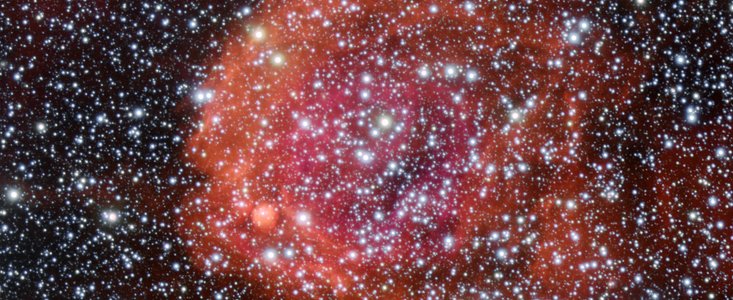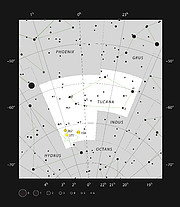Comunicato Stampa
Splendore vermiglio dalle stelle in formazione
30 Marzo 2011
La nube rosso vivo in questa immagine ottenuta con il VLT (Very Large Telescope) dell’ESO è dovuta all’emissione dell’idrogeno ionizzato che circonda l’ammasso stellare NGC 371. Questa incubatrice stellare si trova in una galassia molto vicina a noi, la Piccola Nube di Magellano.
L’oggetto che domina l’immagine può sembrare una pozza di sangue, ma invece di essere associata ad un’immagine di morte, queste regioni di idrogeno ionizzato – note come regioni HII – sono luogo di creazione, in cui con frequenza elevata si formano nuove stelle. NGC 371 è un esempio di questo fenomeno: è un ammasso aperto circondato da una nebulosa. Le stelle nell’ammasso aperto sono tutte nate dalla stessa regione HII e la maggioranza dell’idrogeno è stata via via utilizzata per costruire le stelle, lasciando infine un guscio di gas, come quello che si vede in questa figura, che circonda l’ammasso di stelle giovani e calde.
La galassia ospite di NGC 371, la Piccola Nube di Magellano, è una galassia nana ad appena 200 000 anni luce da noi, è una delle galassie più vicine alla Via Lattea. Inoltre, la Piccola Nube di Magellano contiene stelle a diversi stadi di evoluzone: dalle stelle giovani e luminosissime contenute in NGC 371 ai resti di supernova, rimasugli di stelle morte. Le stelle bambine emettono una gran quantità di radiazione ultravioletta, facendo così risplendere il gas circostante, come ad esempio l’idrogeno rimaso nella nebulosa madre, di vivace luce diffusa per una distanza di centinaia di anni luce in ogni direzione. Il fenomeno è ben rappresentato in questa immagine, ottenuta con lo strumento FORS1 installato sul telescopio VLT (Very Large Telescope) dell’ESO.
Gli ammassi aperti sono tut’altro che rari: molti esempi pregevoli si trovano nella nostra Via Lattea. NGC 371 ha però particolare importanza a causa dell’elevato numero di stelle variabili in esso contenute.
La luminosità delle stelle variabili muta nel tempo. Un tipo particolare di stelle variabili, noto come stelle pulsanti di tipo B a lungo periodo, può essere usato per studiare l’interno delle stelle per mezzo dell’astrosismologia [1]. Molte stelle di questo tipo sono state identificate all’interno dell’ammasso. Le stelle variabili giocano un ruolo fondamentale in astronomia: alcune sono strumento inestimabile per determinare le distanze delle galassie lontane e l’età dell’universo.
I dati utilizzati per produrre questa immagine sono stati estratti dall’archivio dell’ESO da Manu Mejias durante la gara “Tesori Nascosti” [2]. Tre delle immagini di Mejias sono arrivate tra le prime venti nella competizione, mentre la sua elaborazione di NGC 371 si è piazzata sesta.
Note
[1] L’astrosismologia è lo studio della struttura interna delle stelle pulsanti, effettuato osservando le diverse frequenze alle quali esse oscillano. Questo approccio è simile allo studio della struttura della Terra che si effettua osservando i terremoti e la diffusione delle onde da essi provocate attraverso l’interno del pianeta.
[2] La gara “Tesori Nascosti 2010” dell’ESO ha dato agli amanti dell’astronomia l’opportunità di rovistare negli archivi sterminati dell’ESO alla ricerca di una gemma ben nascosta che attendeva di essere resa lucida e brillante da uno dei partecipanti. Sono state spedite circa 100 immagini e i dieci più abili competitori sono stati ben premiati. Tra i premi, un viaggio tutto compreso al VLT dell’ESO sul Cerro Paranal per il vincitore assoluto. I dieci vincitori hanno spedito in totale 20 immagini che si sono piazzate in cima alla classifica.
Ulteriori Informazioni
L’ESO (European Southern Observatory) è la principale organizzazione intergovernativa di Astronomia in Europa e l’osservatorio astronomico più produttivo al mondo. È sostenuto da 15 paesi: Austria, Belgio, Brasile, Danimarca, Finlandia, Francia, Germania, Gran Bretagna, Italia, Olanda, Portogallo, Repubblica Ceca, Spagna, Svezia, e Svizzera. L’ESO svolge un ambizioso programma che si concentra sulla progettazione, costruzione e gestione di potenti strumenti astronomici da terra che consentano agli astronomi di realizzare importanti scoperte scientifiche. L’ESO ha anche un ruolo di punta nel promuovere e organizzare la cooperazione nella ricerca astronomica. L’ESO gestisce tre siti osservativi unici al mondo in Cile: La Silla, Paranal e Chajnantor. Sul Paranal, l’ESO gestisce il Very Large Telescope, osservatorio astronomico d’avanguardia nella banda visibile. L’ESO è il partner europeo di un telescopio astronomico di concetto rivoluzionario, ALMA, il più grande progetto astronomico esistente. L’ESO al momento sta progettando l’European Extremely Large Telescope o E-ELT (significa Telescopio Europeo Estremamente Grande), di 42 metri, che opera nell'ottico e infrarosso vicino e che diventerà “il più grande occhio del mondo rivolto al cielo”.
Contatti
Richard Hook
ESO, La Silla, Paranal, E-ELT and Survey Telescopes Press Officer
Garching bei München, Germany
Tel.: +49 89 3200 6655
E-mail: rhook@eso.org
Joerg Gasser (press contact Svizzera)
Rete di divulgazione scientifica dell'ESO
E-mail: eson-switzerland@eso.org
Sul Comunicato Stampa
| Comunicato Stampa N": | eso1111it-ch |
| Nome: | NGC 371 |
| Tipo: | Local Universe : Star : Grouping : Cluster : Open |
| Facility: | Very Large Telescope |
| Instruments: | FORS1 |



